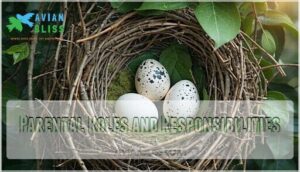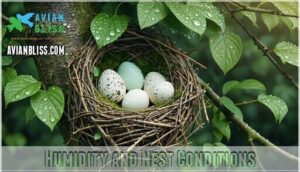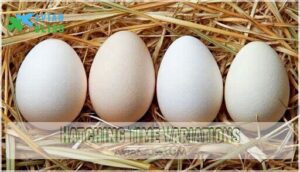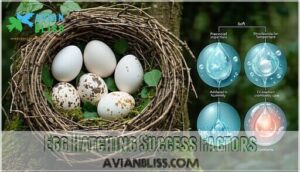This site is supported by our readers. We may earn a commission, at no cost to you, if you purchase through links.
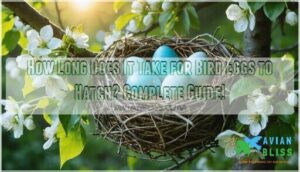
Most backyard favorites like robins and cardinals keep things simple with 12-14 day incubation periods, while chickens clock in at a predictable 21 days.
Think of it like nature’s own timer system – smaller birds tend to hatch faster, while larger species need more time to develop properly.
Temperature, humidity, and even the parent’s dedication all play pivotal roles in this delicate process, creating fascinating variations that reveal nature’s incredible precision and the importance of the right conditions for successful hatching, which can be seen as a form of delicate process.
Table Of Contents
- Key Takeaways
- Bird Egg Incubation
- How Long Eggs Take Hatch
- Incubation Process Explained
- Hatching Time Variations
- Egg Hatching Success Factors
- Frequently Asked Questions (FAQs)
- How long does it take a bird egg to hatch?
- How long do birds incubate their eggs?
- How long do hummingbird eggs take to hatch?
- How long do birds lay eggs?
- How long does it take a chicken to hatch?
- How long do duck eggs take to hatch?
- How long do birds sit on their eggs to hatch?
- Will a mother bird come back if you touch her nest?
- What to do if a bird lays eggs in your yard?
- Do birds stay with their eggs all the time?
- Conclusion
Key Takeaways
- You’ll find that bird egg hatching times vary dramatically by species, ranging from just 10 days for tiny hummingbirds to 80 days for large birds like emus, with most backyard favorites like robins and cardinals taking 12-14 days.
- You need to understand that egg size doesn’t always determine incubation length—a kiwi’s massive egg takes 75 days while an ostrich egg hatches in just 42 days, showing how each species has evolved unique timing strategies.
- You’ll see that successful hatching depends on precise environmental conditions, with parent birds maintaining temperatures between 97°F and 104°F while regularly turning eggs and controlling humidity levels through their dedicated care.
- You can expect different development patterns depending on the bird type—precocial birds like ducks emerge fully feathered and ready to walk, while altricial species like robins hatch helpless and require intensive parental care.
Bird Egg Incubation
When you’re watching bird eggs in a nest, you’ll notice the incubation period varies dramatically based on the species, ranging from just 10 days for tiny songbirds to an impressive 80 days for larger birds like albatrosses.
Nature’s timing is remarkable—from a songbird’s swift 10-day miracle to an albatross’s patient 80-day marathon.
The parent birds work around the clock, maintaining precise temperatures between 97°F and 104°F while regularly turning the eggs to guarantee proper development, much like a dedicated chef monitoring a delicate soufflé.
Factors Affecting Incubation Period
When you’re wondering about egg hatching time, several key factors work together like pieces of a puzzle.
The incubation period depends on multiple elements that can make or break successful hatching.
Here are the main factors affecting incubation length:
- Temperature and humidity levels – Ideal ranges guarantee proper embryo development
- Genetic factors and maternal health – Strong genetics and healthy parents improve success rates
- Altitude effects and nesting material – Environmental conditions influence egg composition and development timing
Bird Species Variations
From tiny hummingbirds to massive ostriches, bird species dramatically influence incubation duration and hatching times.
You’ll find songbirds completing embryonic development in just 10-14 days, while raptors need 30-40 days due to their larger bird size.
These species variations reflect unique breeding environments and survival strategies, with incubation periods ranging from swift 12-day cycles to lengthy 80-day marathons.
The duration is influenced by factors like nest location, which impact the breeding environments and overall hatching times.
Environmental Influences
Environmental factors dramatically shape your bird’s incubation period and hatching time success.
Temperature effects range from 97°F to 104°F for ideal development, while humidity levels prevent egg dehydration or mold growth.
Predation risk forces parents to adjust behaviors, and habitat type influences nest placement strategies.
Climate change increasingly disrupts these delicate patterns, making understanding environmental factors more important than ever.
Birds also rely on photoperiod and day length to activate hormonal responses.
How Long Eggs Take Hatch
Most bird eggs follow predictable hatching timeframes, though you’ll find surprising variety across species. The average incubation period birds experience ranges from 10 to 30 days, with some exceptions stretching up to 80 days for certain species.
Understanding egg hatching time helps you appreciate nature’s timing. Small songbirds like robins complete their hatching process in just 12-14 days, while larger species need more patience. Ostriches require 40-46 days for their massive eggs to develop fully.
Here’s what affects how long hatch times actually take:
- Bird size matters – Smaller birds have faster egg development cycles
- Species genetics – Each type has evolved specific incubation duration patterns
- Environmental conditions – Temperature and humidity influence hatching timeframes
Artificial incubation has revealed consistent patterns in bird egg incubation time. Temperature regulation is vital, with birds using nest insulation and body heat, but humidity control is essential for successful hatching. Whether you’re observing wild nests or managing domestic birds, these species examples show nature’s remarkable precision in timing reproduction cycles.
Incubation Process Explained
You’ve discovered the timing, but now you’ll learn what actually happens inside that egg during incubation.
Think of it as nature’s perfectly controlled oven, where parent birds maintain precise temperature and humidity while regularly turning eggs to guarantee proper development.
Parental Roles and Responsibilities
Successful parental care determines hatching success through dedicated shared incubation duties.
You’ll find most bird species split responsibilities, with female dominance common in many songbirds while males handle night shifts.
Emperor penguins flip the script entirely—males shoulder the entire incubation period alone.
These diverse parental behaviors and bird parenting strategies evolved to maximize survival, ensuring vital incubation behaviors throughout the pivotal development phase.
Nest locations depend on protection from predators, which is crucial for the development phase and overall parental care.
Egg Turning and Temperature Control
You’ll need to turn eggs at least five times daily to prevent the embryo from sticking to the shell.
Temperature control remains critical—maintain 99.5°F to 100°F using your brood patch’s heat transfer.
Automated turning systems help commercial operations, while wild birds instinctively rotate eggs.
Temperature gradients across the nest can affect development, so consistent warmth through proper nest insulation guarantees successful incubation periods, ensuring the embryo develops in a stable environment.
Humidity and Nest Conditions
Proper humidity control acts like a delicate balancing act during the incubation period.
You’ll find that nest material and nest location naturally regulate egg moisture levels.
Too much humidity encourages fungal growth, while too little causes dehydration.
Environmental factors like rainfall affect nesting conditions, so parent birds instinctively adjust their behavior.
Consider using nest humidity controllers to maintain ideal conditions.
Smart hatching time depends on maintaining this vital moisture balance, which is crucial for the incubation period and overall humidity control.
Hatching Time Variations
You’ll find that bird egg hatching times vary dramatically across species, ranging from just 10 days for tiny songbirds to an impressive 80 days for large seabirds like the Wandering Albatross.
This wide range depends on factors like the bird’s size, egg weight, and unique evolutionary adaptations that help each species survive in their specific environment, which is influenced by the bird’s size.
Species Differences and Adaptations
Understanding how different bird species have evolved unique timing strategies reveals nature’s incredible diversity.
Each species has developed specific incubation duration patterns that match their survival strategies and breeding environments perfectly.
Here’s how species comparison shows remarkable adaptations:
- Songbirds complete embryonic development in just 10-14 days with higher metabolic rates
- Raptors require 30-40 days for complex neural system development
- Waterfowl need 28-35 days to prepare waterproof feathers
- Hummingbirds hatch in 12 days despite tiny egg size
- Ostriches take 40-46 days for their massive offspring
These avian incubation strategies reflect millions of years of evolutionary fine-tuning.
Ambient temperature can also influence egg development rates, affecting incubation duration.
Egg Size and Weight Considerations
When you compare different birds, you’ll notice that larger eggs don’t always mean longer incubation periods.
A kiwi’s massive egg (22% of her body weight) hatches in 75 days, while an ostrich egg takes just 42 days despite weighing three pounds.
This Size vs. Incubation relationship reflects each species’ unique Parental Investment strategy and Egg Size Survival needs.
Climate Change Impacts
Climate change is reshaping how long bird eggs take to hatch across the globe.
Rising temperatures can shorten incubation periods, while extreme weather events disrupt normal hatching cycles.
You’ll notice these environmental shifts affecting bird populations in ways that ripple through entire ecosystems.
- Altered Hatching timing disrupts food availability when chicks need it most
- Shifting Ranges force birds into unfamiliar territories with different incubation challenges
- Habitat Loss from extreme weather reduces safe nesting sites for successful reproduction
Egg Hatching Success Factors
You’ll find that successful egg hatching depends on several key factors, including proper incubation temperature, adequate humidity levels, and the parent bird’s ability to maintain consistent care through their specialized brood patch.
The miracle of bird hatching unfolds through nature’s perfect balance of warmth, timing, and devoted parental care.
Whether you’re observing precocial birds like ducks that hatch ready to walk, or altricial species like robins that emerge helpless and featherless, these biological adaptations work together like a perfectly timed recipe for new life.
Brood Patch and Incubation Methods
You’ll notice that most birds shed off their belly feathers before incubation begins.
This feather loss creates a warm, bare brood patch that transfers heat directly to eggs.
Parents take turns warming eggs, rotating them regularly for even development.
Birds may require supplemental brood patch products in certain conditions.
| Incubation Method | Heat Transfer Technique |
|---|---|
| Brood Patch Contact | Direct skin-to-egg warmth |
| Nest Positioning | Body coverage for insulation |
| Parental Shifts | Alternating warming duties |
Precocial and Altricial Bird Development
When bird eggs hatch, you’ll notice two distinct development differences: precocial and altricial species.
Precocial birds like ducks emerge fully feathered with advanced brain development after longer incubation periods, requiring less parental investment.
Altricial birds such as robins hatch helpless after shorter hatching times, demanding intensive care but allowing faster growth rates and flexible survival strategies.
These strategies reflect evolutionary pressures and environmental adaptations.
Frequently Asked Questions (FAQs)
How long does it take a bird egg to hatch?
Like nature’s own countdown timer, you’ll watch bird eggs transform into chirping bundles of feathers in anywhere from 10 to 80 days, depending on the species you’re observing in your backyard adventures.
How long do birds incubate their eggs?
You’ll find that incubation periods vary dramatically by species, ranging from 10 to 80 days.
Smaller songbirds typically sit on their eggs for 10-14 days, while larger birds like ostriches incubate for 40-46 days consistently.
How long do hummingbird eggs take to hatch?
Hummingbird eggs typically hatch in just 12-16 days, making them among nature’s quickest developers.
You’ll find these tiny eggs need consistent warmth and humidity to successfully complete their remarkably fast incubation period.
How long do birds lay eggs?
You’ll find most songbirds lay eggs over 3-6 days, typically one per day.
Larger birds like raptors might take longer, spreading their egg-laying across a week or more depending on clutch size.
How long does it take a chicken to hatch?
Sarah’s backyard chickens started sitting on their eggs, and she wondered when the fluffy chicks would arrive.
You’ll see your chicken eggs hatch in exactly 21 days if you maintain proper temperature and humidity conditions.
How long do duck eggs take to hatch?
Duck eggs typically take 28 days to hatch, though this can vary slightly by breed.
You’ll need to maintain consistent temperature and humidity during incubation, turning the eggs regularly for proper development.
How long do birds sit on their eggs to hatch?
Birds typically sit on their eggs for 10 to 80 days, depending on their species.
You’ll see smaller songbirds incubating for just 12-14 days, while larger birds like ostriches dedicate 40-46 days to hatching.
Will a mother bird come back if you touch her nest?
Most mother birds will return to their nests even after you’ve touched them.
The "human scent abandonment" myth isn’t true—birds have poor smell.
However, minimize disturbance since repeated handling can stress parents and affect their care.
What to do if a bird lays eggs in your yard?
Keep your distance and let nature take its course.
Don’t disturb the nest or eggs. Most birds will abandon their eggs if you interfere.
Watch from afar and enjoy this special wildlife moment.
Do birds stay with their eggs all the time?
Like devoted guardians at their post, most birds don’t stay with their eggs constantly.
You’ll notice parents take shifts, leaving briefly for food while maintaining warmth and protection through shared incubation duties.
Conclusion
Understanding how long it takes for bird eggs to hatch is absolutely mind-blowing when you consider the incredible precision involved.
You’ve learned that timing varies dramatically from 10 days for hummingbirds to 80 days for emus, with most backyard birds averaging 12-21 days.
Temperature, humidity, and parental care all influence success rates.
Whether you’re a birdwatcher, backyard enthusiast, or simply curious about nature, you’ll now appreciate the remarkable complexity behind each successful hatch in your neighborhood.
- https://birdsinthetree.com/when-do-birds-eggs-hatch/
- https://www.hummingbirdsplus.org/nature-blog-network/the-incubation-period-for-bird-eggs-varies-among-species/
- https://birdsspotter.com/how-long-for-a-birds-egg-to-hatch/
- https://adaintymum.blog/bird-incubation-egg-development/
- https://pmc.ncbi.nlm.nih.gov/articles/PMC2606727/

